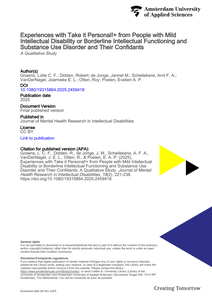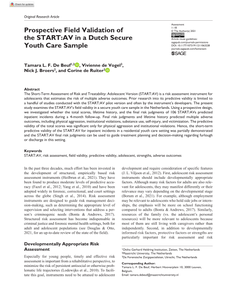Background: The prevalence of Substance Use Disorder (SUD) in people with Mild IntellectualDisability and Borderline Intellectual Functioning (MID-BIF) is high and evidence-basedtreatment programs are scarce. The present study describes the development of a personalised SUD treatment for people with MID-BIF.Method: The personalised SUD treatment is developed according to the steps of the InterventionMapping approach, based on literature review, theoretical intervention methods, clinicalexperience and consultation with experts in the field of addiction and intellectual disability care.Results: We developed a treatment manual called Take it Personal!+. Take it Personal!+ aims toreduce substance use, is based on motivational interviewing and cognitive behavior therapyand personalised based on the client’s personality profile. Furthermore, an mHealth application supports the treatment sessions.Conclusion: Take it Personal!+ is the first personalised SUD treatment for individuals with MID-BIF.Future research should test the effectiveness of Take it Personal!+ in reducing SU.
DOCUMENT

Substance abuse is an important risk factor for offending, but is mostly studied in males. The aim of this multicentre study is to gain insight into possible gender differences in substance abuse history and offending behavior in forensic psychiatric patients. Files were analyzed of 275 women and 275 matched men who have been admitted between 1984 and 2014 to one of four Dutch gender-mixed forensic hospitals. Risk assessment ratings were related to registered violent incidents during treatment for both women and men and to official recidivism data after discharge for a subgroup of 78 women. Substance abuse history was coded as a risk factor for more than half of the women (56.7%), but significantly more often for men (68.4%). Men were more often diagnosed with substance dependence and more frequently committed the index-offense whilst intoxicated. Prediction of violent incidents during treatment was more accurate for men. A history of substance abuse was not a significant predictor for recidivism after discharge in the subgroup women. It is concluded that there are gender differences in substance abuse history and that the relationship with offending behavior seems stronger for men. These differences have implications for substance use treatment in forensic mental health services.
DOCUMENT
Health professionals’ attitudes to substance abusers have been reported as suboptimal with potential adverse consequences for the quality of health care provided. Less is known about professionals working with addicted clients in mandated contexts. The aim of this study is to gain insight into forensic social professionals’ attitudes to substance use and examine differences between subgroups of professionals. An online survey including the Brief Substance Abuse Attitude Scale was completed by 314 Dutch forensic social professionals. Overall, forensic social professionals’ attitudes to substance use and treatability were positive, but there were differences regarding needed treatment interventions and ways of controlling substance use. Professionals who work within specialist addiction services had less moralistic and stereotypical attitudes. Professionals who have personal experiences with addiction reported to be more tolerant, but at the same time more convinced of strict control of substances use of their clients
DOCUMENT
IntroductionTake it Personal!+ is a treatment program for individuals with Mild Intellectual Disability or Borderline Intellectual Functioning (MID-BIF) and Substance Use Disorder (SUD). It is supported by a mobile health application (mHealth), and researchers found it can reduce Substance Use (SU). Aims: This study aimed to explore the usability of the treatment program in as experienced by clients and their confidants.MethodsWe conducted post-treatment, semi-structured interviews with clients (n = 8) and their confidants (n = 8). We coded transcripts according to thematic analysis and using inductive and deductive methods. Subsequently, we analyzed connections between the codes and grouped them into themes using axial coding.ResultsOverall clients and confidants experienced the treatment program as usable, and most mentioned the program helped to reduce SU. The clients and confidants reported the presence of a confidant was helpful. Some clients and confidants reported the mHealth application was helpful. Components that were perceived as effective were self-control skills, daily registration exercise and discussing quantity of SU non-judgingly. Perceived impeding factors were video calling and a non-supportive network.ConclusionThis study shows that Take it Personal!+ is an useable treatment program for individuals with MID-BIF and SUD, that helps to decrease their self-reported SU. Nevertheless, there is room for improvement for further adapting the treatment, which will be discussed.
DOCUMENT

Introduction: Hardly any research exists on the relationship between substance use and sexual behaviors in patients with a substance use disorder. This study aimed to examine this relation by looking into perceived positive effects on sexual behavior, perceived negative effects and risky sexual behavior due to substance use in patient groups of users of alcohol, stimulants, sedatives and Gamma hydroxybutyrate (GHB). In addition, the current study aimed to address the question whether sexual behavior (e.g. number of sexual partners, sexualactivity) differs between these patient groups.Method: A total of 180 patients with a substance use disorder (i.e. alcohol, amphetamine, cannabis, cocaine, GHB and opiates) participated. A self-report questionnaire was administered with questions on substance use,sexual behaviors (e.g. sexual activity, masturbation, use of pornography) and statements about the perceived changes in sexual functioning and behavior under influence of the primary substance of abuse.Results: All four groups reported changes in sexual thoughts, feelings and behavior due to the use of their primary substance. More than half of the patients reported enhancements in sexual domains (i.e. sexual pleasure,sexual arousal, sexual behavior), but also decrements or risky behaviors and about a quarter stated that their sexual thoughts, feelings and behaviors were often associated with the use of their primary substance of abuse.Patients with a GHB use disorder reported the strongest relation between drug use and sexual behavior. Users of HB not only reported more enhancement in several sexual domains, but also less decline in sexual domains compared to the other patient groups and more risky behavior or more sexual activity than some of the other groups of patients.Conclusions: The results underline the importance of addressing the relationship between substance use and sexual behavior in treatment programs, as patients may be hesitant to stop their use of substances when they experience many positive effects in their sexual behavior. Future research directions are suggested.
DOCUMENT

Although the literature consistently shows an association between parental substance use disorders (SUDs) and child abuse, it is unknown what factors discern non-abusive and abusive parents with SUDs. This study aims to investigate which specific risk factors are associated with child abuse in clinically treated parents with SUDs in the Netherlands. It examines two groups of parents with SUDs in a clinical setting, with and without known instances of child abuse. These groups were compared on SUD-related factors such as the type and severity of the SUDs, and variables addressing psychological disability such as comorbid diagnoses and quality of life. Besides a marginally significant difference in severity of addiction and a lower mean age of the parents in the child abuse group, no significant differences were found. The small sample size and the inherent difficulty of studying SUDs in a clinical sample likely affected the results
DOCUMENT
The Short-Term Assessment of Risk and Treatability: Adolescent Version (START:AV) is a risk assessment instrument for adolescents that estimates the risk of multiple adverse outcomes. Prior research into its predictive validity is limited to a handful of studies conducted with the START:AV pilot version and often by the instrument’s developers. The present study examines the START:AV’s field validity in a secure youth care sample in the Netherlands. Using a prospective design, we investigated whether the total scores, lifetime history, and the final risk judgments of 106 START:AVs predicted inpatient incidents during a 4-month follow-up. Final risk judgments and lifetime history predicted multiple adverse outcomes, including physical aggression, institutional violations, substance use, self-injury, and victimization. The predictive validity of the total scores was significant only for physical aggression and institutional violations. Hence, the short-term predictive validity of the START:AV for inpatient incidents in a residential youth care setting was partially demonstrated and the START:AV final risk judgments can be used to guide treatment planning and decision-making regarding furlough or discharge in this setting.
DOCUMENT

The body of evidence that the working alliance is associated with positive outcomes for mandated clients is growing. The aim of this research was to investigate the influence of several characteristics of probation officers (POs) and offenders on the course of the working alliance during probation supervision. This study examined the patterns on the four alliance subscales: Trust, Bond, Goals-Restrictions, and Reactance of the Working Alliance With Mandated Clients Inventory (WAMCI) in 201 offenders and their 137 POs. Three patterns on each alliance subscale were found: deteriorating, improving, and stable. Multinomial logistic analysis revealed that change of POs and the preference of the PO to maintain rules were associated with a deteriorating Trust pattern. From the perspective of the offenders, being motivated to take part in supervision was associated with a stable pattern on every alliance subscale, but having problems with substance use increased the likelihood of a deteriorating pattern on every alliance subscale.
DOCUMENT

Bipolar disorder is a severe mental illness with serious consequences for daily living of patients and their caregivers. Care as usual primarily consists of pharmacotherapy and supportive treatment. However, a substantial number of patients show a suboptimal response to treatment and still suffer from frequent episodes, persistent interepisodic symptoms and poor social functioning. Both psychiatric and somatic comorbid disorders are frequent, especially personality disorders, substance abuse, cardiovascular diseases and diabetes. Multidisciplinary collaboration of professionals is needed to combine all expertise in order to achieve high-quality integrated treatment. 'Collaborative Care' is a treatment method that could meet these needs. Several studies have shown promising effects of these integrated treatment programs for patients with bipolar disorder. In this article we describe a research protocol concerning a study on the effects of Collaborative Care for patients with bipolar disorder in the Netherlands.
DOCUMENT

Research shows that victimization rates in forensic mental health care are high for both female and male patients. However, gender differences have been found in types and patterns of victimization (more sexual abuse and more complex trauma for women), cognitive appraisal, and response to traumatic events. Gender-responsive treatments focusing on trauma have been designed to adhere to these gender differences; however, despite promising research results, these interventions are yet to be introduced in many settings. This study examined how trauma is addressed in current clinical practice in Dutch forensic mental health care, whether professionals are knowledgeable of gender differences in trauma, and how gender-responsive factors such as self-esteem, self-efficacy, social relations, and coping skills are considered in treatment for female patients. We used a mixed-method design consisting of an online survey and 33 semi-structured interviews with professionals and patients. The results suggested that Dutch forensic mental health care could address trauma more structurally, and professionals could be more aware of gender differences and gender-responsive factors. Early start of trauma treatment was deemed important but was not current practice according to patients. Based on this study, guidelines were developed for gender-responsive, trauma-informed work in forensic mental health care.
DOCUMENT
